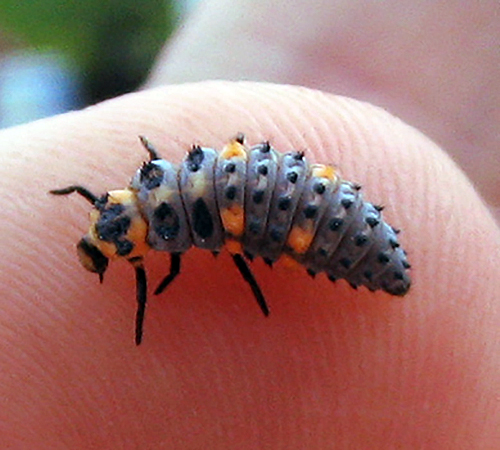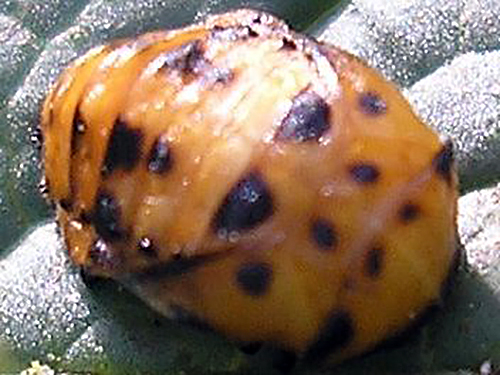
A ladybug goes through the same four stages that make a butterfly: the egg stage, the larva stage, the pupa stage, and the adult stage. You know what adult ladybugs look like, but you might not recognize them before they get to their final form. This alligator-like creature is the larva stage. Wikimedia commons photo.
15 Apr 2016 – The Life of a Ladybug
My husband has gotten into roses lately. He has even had some success growing new rose bushes from cuttings, a feat I have not yet mastered. So when a friend brought us a rose cutting a few days ago, I was about to give it to Robert. But I decided to identify it first, if I could. There are a lot of rose varieties that have been used in gardens for decades, even centuries.
As I looked over the cutting I was struck by how healthy it was. No black spots or other blemishes were on the leaves. Insects had not chewed holes in the rich red flowers. The twig had about a dozen leaves on it and they were a bright green and undamaged by bugs. And then I saw it: an insect. It was black with a couple of orange patches on its sides. I could see it had six tiny legs and could move about. It resembled an alligator, at least as far as anything only a quarter inch long could resemble an alligator!

After a couple of weeks of feasting and growing, the larva will change into something that looks like a tiny shrimp stuck to a leaf. It will seem to fall asleep for a few days, and during that time, the larva is going through metamorphosis and becoming an adult ladybug. Wikimedia commons photo.
I knew this tiny alligator sitting on the top of a leaf was a larval ladybug. And I knew it was a good thing: ladybug larvae eat almost as many aphids and other plant-eating bugs as the adult ladybugs do. No wonder there were no other insects on this rose twig!
Wait a moment: what was that funny humped- up orange and black thing on another leaf? I saw it was attached to the leaf surface at one end and it was not moving. I realized it, too, was a ladybug. It was the pupa stage. Unlike butterflies which spin a cocoon around themselves during pupation, ladybug larvae just seem to become little mummified “alligators.” Inside their last larval skin, the pupa becomes transformed into an adult ladybug.
Whoa, wait again! There was an adult ladybug on the next leaf over. It was a quarter-inch long red half-dome with black spots. I let it crawl on to my hand. It walked to the end of my thumb and then the half-dome split in half along its midline! The insect’s flying wings extended, and it flew off.
I was quite pleased that I had seen three of the four stages of a ladybug’s life on one little sprig of rose bush. I wondered if the rose had any aphids sucking on it. I looked under a leaf. No aphids. But there was something: a tiny cluster of golden, spindle-shaped eggs. These eggs were the remaining stage of the ladybug life cycle!
Ladybugs, which are not true bugs but beetles, have a complete metamorphosis. This means they go through four distinct stages during their life cycle. Since it is a circle, you can start anywhere, and come back to where you started. Let’s start with the eggs. Eggs hatch in three to five days depending on the temperature. The first larvae out of the eggs are the tiny, bristly black “alligators.” At this point they are smaller than a pinhead. But they are fierce! They began hunting down and eating aphids right away. A single larva can eat 25 aphids a day! Soon the larva outgrows its skin, so it casts off the old skin in a process called molting. As they continue to grow, the larvae molt three times. The little “alligators” change a bit with each molt, getting some orange patches on them as well as getting bigger. After about two weeks, the larvae attach themselves by their tail to a leaf or stem. Outwardly, they seem to be doing nothing but hunching up. Inside, complex bio-chemical processes break down the larva’s body and transform it into an adult ladybug. This stage, pupation, takes about five to seven days.
When the adult is ready to emerge, the pupa splits and a soft, but fully formed, insect crawls out. It can take up to a day for the exoskeleton to “dry out” and harden. As it does the wing covers (called elytra) get the characteristic red-orange coloration and black spots. Then the adult ladybug begins to feed—voraciously—on soft-bodied insects like aphids, mealybugs, scale insects, and mites. One adult ladybug can eat 50 aphids a day, and as many 5000 in its lifetime.
Sooner or later, a female ladybeetle will encounter a male ladybeetle (perhaps better called a “gentlemanbeetle”) and they will mate. The male’s genitalia must match the female’s genitalia exactly, like a key in a lock, for mating to be successful. This is vital to prevent accidental cross-breeding among the almost 5000 species of ladybeetles in the world.
The mated female seeks out a plant infested with aphids and lays her eggs, in clusters of a dozen or so at a time, on the underside of a leaf. The cycle starts over. She will continue to lay eggs for most of her life, which lasts for about nine months in most species. One female ladybug may lay1000 eggs between spring and summer.
Many people like to release ladybugs in their yards and gardens as a kind of biological control of insect pests. The species of ladybug that is used for release is the Convergent Ladybeetle (Hippodamia convergens). This species migrates to higher altitudes in winter and converges into large flocks in conifers. Collectors brush masses of ladybugs into bags and take them to labs were they are allowed to finish hibernation. Responsible collectors insure that the ladybugs are well-fed and ready lay eggs when they are sold to gardeners. These wild-caught Hippodamia convergens are also hungry. Gardens with plenty of soft-bodied insect pests are Eden to these ladybugs. As long as there is food, the collected Convergent Ladybeetles will stay in their new home.
If you have never tried releasing ladybugs into your garden, why not try it this spring? They are readily available on Amazon.com and at some garden centers. Also, our local garden club will offer them at the Spring Plant Sale on April 30th. Go ladybeetles!
If you would like to offer comments, please click through to the discussion page
